![]()
![]()
![]()
Use LEFT and RIGHT arrow keys to navigate between flashcards;
Use UP and DOWN arrow keys to flip the card;
H to show hint;
A reads text to speech;
58 Cards in this Set
- Front
- Back
- 3rd side (hint)
|
Suction: down. Fixed meter Head pressure: down Superheat: up Subcool: down Comp. Amps: down Delta T: down |
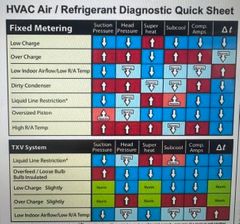
Low charge Fixed orific sends all of the refrigerant through but the Superheat is up because there isnt enough refrigerant. Then the suction pressure stays low. Suction pressure is low so the discharge pressure is low. Then the gas flies through the condenser so the sub cooling is low. |
|
|
|
Suction: up. Fixed meter Head pressure: up Superheat: down Subcool: up Comp. Amps: up Delta T: normal-down |
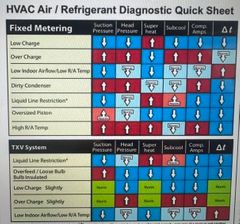
Over charge Superheat is down because the refrigerant is not boiling off which absorbs the most heat. Still there is too much refrigerant so the suction pressure remains high. High suction means high discharge. Then all the refrigerant gets stuck in the condenser and subcooling is high because it is hanging out there too long. Note: if this was a txv (1) superheat might be normal, SST might be normal, and delta T might be normal…. Because txv is doing its job. AND SUB-COOLING might be normal because refrigerant is backing up in the receiver and not the condenser. For a txv system with a reciever the high pressure is high so the condenser split is High. And that the only thing you will see with an overcharge. |
|
|
|
Suction: down. Fixed meter Head pressure: normal-down Superheat: down Subcool: normal-down Comp. Amps: normal-down Delta T: up |

Low indoor Ambient Low return air temp |
Superheat is down and the delta T is up |
|
|
Suction: up. Fixed meter Head pressure: up Superheat: normal-down Subcool: normal-down Comp. Amps: up Delta T: down |
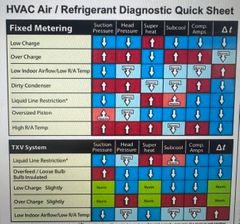
Dirty condenser The amps are up, pressures are up, but the TD is down. Subcooling is normal because the correct amount of refrigerant. However, superheat is high because of the head pressure is pushing refrigerant through the fixed metering device. |
Delta T is down so its not a high ambient air at the condenser. |
|
|
Suction: down. Fixed meter Head pressure: normal-down Superheat: up Subcool: normal-up Comp. Amps: down Delta T: down |
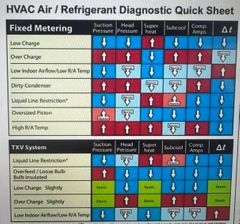
Liquid line restriction Sub cooling is up so refrigerant is backing up in the condenser. Amps,pressures, delta T are all down. Superheat is up because there is no refrigerant. Suction/discharge high = high mass flow |
|
|
|
Suction: normal-up. Fixed meter Head pressure: normal-down Superheat: down Subcool: down Comp. Amps: down Delta T: down |

Oversized piston Superheat is down, flooding the evaporator. Subcooling is down. Refrigerant isnt backing up in the condenser. |
Suction/discharge high = high mass flow |
|
|
Suction: up. Fixed meter Head pressure: up Superheat: up Subcool: normal-down Comp. Amps: up Delta T: down |
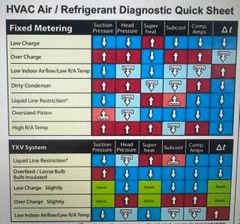
High R/A Temp
Suction/discharge high = high mass flow |
Suction/discharge high = high mass flow |
|
|
TXV Suction: down Head pressure: normal-down Superheat: up Subcool: normal-up Comp. Amps: down Delta T: down |
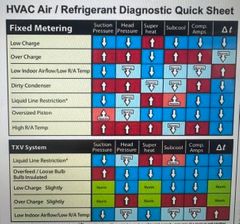
Liquid line Restriction
Suction/discharge low = low mass flow |
Suction/discharge low = low mass flow |
|
|
TXV Suction: up Head pressure: down Superheat: down Subcool: down Comp. Amps: down Delta T: down |

Overfeeding/loose bulb/bulb not insulated |
Kinda looks like a low load… but suction pressure is up. Kinda looks like an undercharged system but superheat is down. |
|
|
TXV Suction: normal Head pressure: down Superheat: normal Subcool: down Comp. Amps: down Delta T: normal |

Low charge slightly |
|
|
|
TXV Suction: normal Head pressure: up Superheat: normal Subcool: up Comp. Amps: up Delta T: normal |
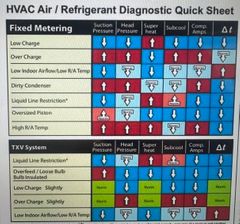
Overcharge slightly |
|
|
|
TXV Suction: down Head pressure: normal-down Superheat: down Subcool: normal-down Comp. Amps: normal-down Delta T: up |
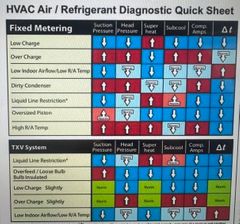
Low indoor airflow/ Low R/A temp Suction/discharge low = low mass flow |
Suction/discharge low = low mass flow |
|
|
What measurements do you need to correctly diagnose a system? |
(1) Ambient condenser temperature (2) Condensing temperature (3) Condenser split (4)condenser subcooling At the evap (1)return air (2)evap SST (3) Evap TD (4) evap superheat |
|
|
|
Causes the condensing temperature drops? |
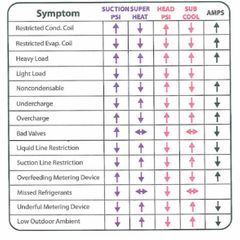
(1)Low ambient (2)low load on evap (3)low charge |
|
|
|
What causes High condensing temperature? |
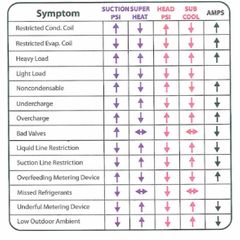
(1)high ambient (2)high load on evap (3)over charge Etc… |
|
|
|
What happens on a cap tube system when ambient drops? |
Since there is low head pressure pushing liquid into the metering device, less refrigerant is fed into the evaporator, starving it, causing higher superheat.
|
|
|
|
What is the big problem with fixed metering systems? |
Underfeed on high load. And Overfeeds on low load. —————- Low ambient causes under feeding. High ambient causes overfeeding. ——————- Takes a while to balance the system. |
|
|
|
Suction: high. Fixed meter Head pressure: high Superheat: low Subcool: high Comp. Amps: high Delta T: normal |
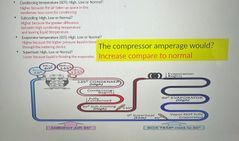
Non-condensable in system
(1)Non-condensables collect at the top of the condenser effectively limiting the size of the condenser. (2)The high side pressure goes up till the refrigerant condenses and moves to the low side. |
|
|
|
Inefficient compressor High pressure= Low pressure= Subcooling= Superheat= Amps= |
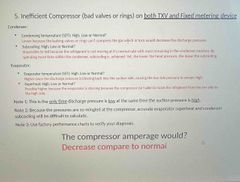
TXV or Fixed metering device
Condensing temperature: Low Subcooling: ??? Evaporator: higher than normal Superheat: higher The only time you have high suction and low discharge |
|
|
|
Dirty/iced evaporator fixed orific? High pressure= Low pressure= Subcooling= Superheat= Amps= |
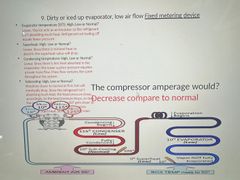
Back (Definition) |
|
|
|
Restriction in the Liquid line BEFORE the reciever TXV system? High pressure? Low pressure? Superheat? Subcooling? Amps? |
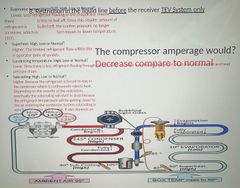
Back (Definition) |
|
|
|
Restriction in the liquid line after the receiver IEV System only? High pressure? Low pressure? Superheat? Subcooling? Amps? |
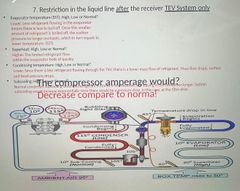
Back (Definition) |
|
|
|
Partially restricted txv? High pressure? Low pressure? Superheat? Subcooling? Amps? |
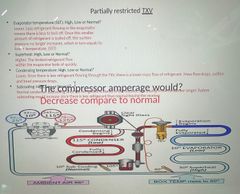
Back (Definition) |
|
|
|
Partially restricted fixed metering device? High pressure? Low pressure? Superheat? Subcooling? Amps? |
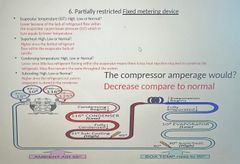
Back (Definition) |
|
|
|
What is the normal cause of compressor failure? |
Compressor failure is normally caused by improper compressor lubrication True cause of compressor is 80% mechanical and 20% electrical. (Electrical is now 8%) |
|
|
|
What type of compressor is the easiest to perform a field analysis. |
Semi-hermetic
The valve plates can be changed. |
|
|
|
Reasons for compressor failures? |
-refrigerant floodback If you dont have superheat then a constant stream of liquid refrigerant will be fed to the compressor. -flooded starts Refrigerant inside the crankcase settles under the oil explodes when the compressor starts. -slugging A large amount of liquid accessing the piston on the suction stroke at once -overheating -loss of oil -contamination |
|
|
|
If there is a blowby what will the pressure in the crankcase? |
The high pressure will blowby the piston rings and into the suction pressure side.
This will equalize the pressures and trip the oil pressure differential control. |
|
|
|
Even if you loose the evaporator fan no refrigerant will return to the compressor? This system is charged to sight glass or critically charged? |
Critically charged |
|
|
|
What is liquid refrigerant floodback? Defined? When? Causes? |

The oil mixes with the liquid refrigerant and causes bad lubrication. Seized, spun, worn bearings. Metal on metal contact. The damage is located at the bottom of the compressor where the oil is located. |
|
|
|
Air cooled vs suction cooled? Location of SSV? |
Air cooled uses the suction service valve is attached to the head
Refrigerant cooled (suction cooled) uses the suction service valve is attached to end bell of the motor section.
System superheat is (min20- max50F) |
|
|
|
Where is the floodback damage located on a suction cooled compressor? |
Progressive damage will show up on the crankshaft. Oil gets in the housing mixes with the oil to form an emersion and is pumped through the crankshaft journals. |
|
|
|
What is the normal distance between the stator and the rotor? |
1/16 inch Worn journals make the crankshaft wobble… the rotor might hit the edge of the stator and cause a short. Killing the conpressor. |
|
|
|
Flood back kills the compressor after the rotor shorts to the stator. You replace the compressor and what? |
A new metering device. |
|
|
|
Cause of floodback |
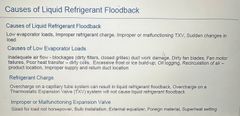
(1)TXV overfeeding (2) Overcharged IF YOUR TXV IS WORKING YOU WILL HAVE SUPERHEAT (3)Low evaporator load, Low airflow, dirty evaporator, fan motor failure.
(4)Oil logging Not enough defrost causes the stays in the evaporator and coats the walls of the tube passes. the oil makes bad heat transfer. The refrigerant doesnt boil off and causes no superheat. |
|
|
|
Approximate superheat settings according to emerson? |

Back (Definition) |
|
|
|
Floodback prevention? Name 5 things |

Back (Definition) |
|
|
|
448 is a replacement for 404A. How do you calculate superheat? |
You need to use the number between dew and bubble. Usually you use the dew point. Superdewper
(1)Check the pressure then find the dew point (5F) and the Bubble (-5F). (2) R-448 wants you to use the average between dew and bubble so 0F would be the SST. Note: glide is the difference between bubble and dew. In this case the glide is 10F. |
|
|
|
Field analysis Name 4 things |
(1)Check oil sight glass Excessive foaming maybe floodback? (2)Check superheat (3)Shake hands with the crankshaft Looking for play up and down, left and right, not in and out. (4) remove heads and look for wear. Check oil pump. Check for bearing wear. |
|
|
|
What is refrigerant migration? What is a flooded start? |
When the compressor is off… migration can happen. It will collect in the coldest place. It will condense and move below the oil in the compressor. When the compressor starts it will form a oil bubble filled with refrigerant. The oil will lubricate and “pop” and the refrigerant will wash off the oil. Causing bad lubrication. If the foaming very bad the oil bubbles will make it into the piston stroke and liquid will stay in the piston during the compression stroke. |
|
|
|
Flood back air cool reciprocal compressor will become slugging? |
When the liquid goes into the piston down stroke the liquid flooding back might not all boil off. This remaining liquid will remain during the compression stroke and this is slugging. |
|
|
|
If it a suction cooled compressor and you have flooded starts gets really bad it will become slugging? |
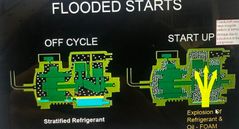
Yes.
The explosion of FOAM (oil bubbles filled with liquid refrigerant can make its way in the suction inlet of the recip inlet and cause slugging. |
|
|
|
Best way to prevent flooded start? |

The best way to prevent Use crankcase heater with a proper pump down cycle! |
|
|
|
Causes of slugging |

Back (Definition) |
|
|
|
What do the last three digits mean on a coupland compressor? -289 or -800? The number in the hundreds -X00 will tell you something? |
The original one will have more oil First digit is 0-1-2 then it is original. If the first number is a 7,8, or 9 then the compressor is a replacement and has less oil. |
|
|
|
Will an accumulator completely prevent liquid migration on the off-cycle? |
No, migration can still occur depending on temperature difference. |
|
|
|
Causes of overheating? 7 causes |

Low suction pressure means less refrigerant mass flow. |
|
|
|
What does emerson want for system superheat? |
Max 50F Min 20F |
|
|
|
Causes of high compression ratio? Causes of low suction, name 5?
Causes of high condensing pressure, name 6? |

Back (Definition) |
|
|
|
Overheating oil REMEMBER THESE ONES! |

330-350F mineral oil breakdown 380-400F poe oil breakdown 350-400F lip seals degrade and scrolls gall
Note: the INTERNAL TEMPERATURE OF THE SCROLL IS 50-75F HIGHER THAN THE TEMPERATURE OF THE DICHARGE LINE MEASURED 7 inches away from the compressor (6 inches) |
|
|
|
Oil return checkvalve does what? |
Valve closes only when the crankcase pressure is HIGHER than the motor compartment pressure. |
|
|
|
Maximum discharge line temperatures? |
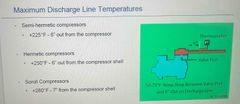
These temperatures are trying to account for the oil breakdown point
330-350F mineral oil breakdown 380-400F poe oil breakdown 350-400F lip seals degrade and scrolls gall |
|
|
|
How do you calculate compression ratio? |
Absolute discharge / absolute suction 5:1? |
|
|
|
Loss of oil?? 5 reasons Oil in = oil out |

No oil return Oil is at the highest after a defrost. If you can see oil after a defrost. You are good (coupland), Carlisle will tell you what you should be seeing.
2 most common reasons for loss of oil (1) inadequate defrosts (2) loss of charge —————— |
|
|
|
System contamination causes acid formation? What is copper plating? |
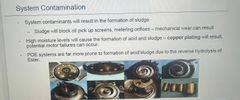
Copper plating happens when the acid eats away the copper in the pipes and deposites it on the hot surfaces like piston heads. Acid will also eats the windings on the rotor. |
|
|
|
Hp per ton for each temperature? |
1 hp high (ac) 1.5 hp mid (fridge) 2 hp low (freezer) |
|
|
|
Hp per ton for each temperature? |
1 hp high (ac) 1.5 hp mid (fridge) 2 hp low (freezer) |
|
|
|
Insulation thickness |
3/4 low 1/2 mid 3/8 high |
|

